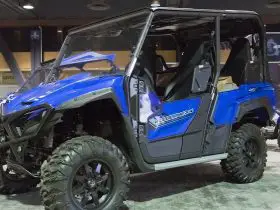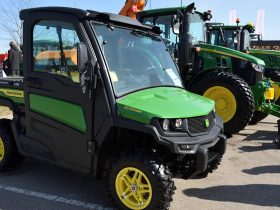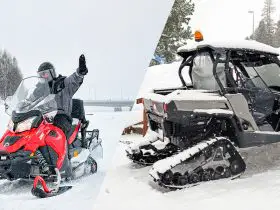What if we told you that the entire utility vehicle category was born on a napkin?
Yamaha Viking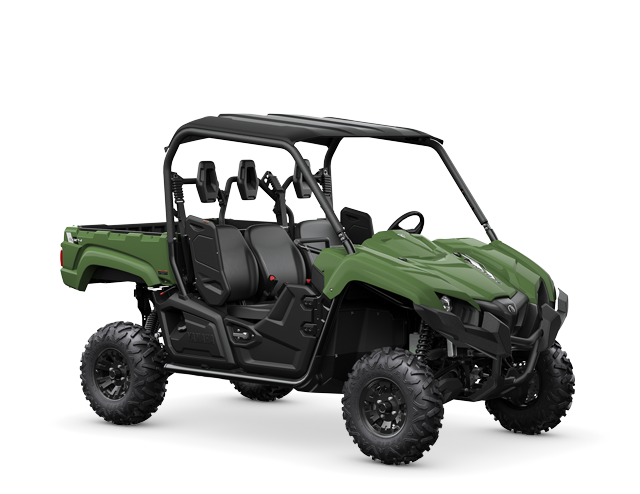 | Kawasaki Mule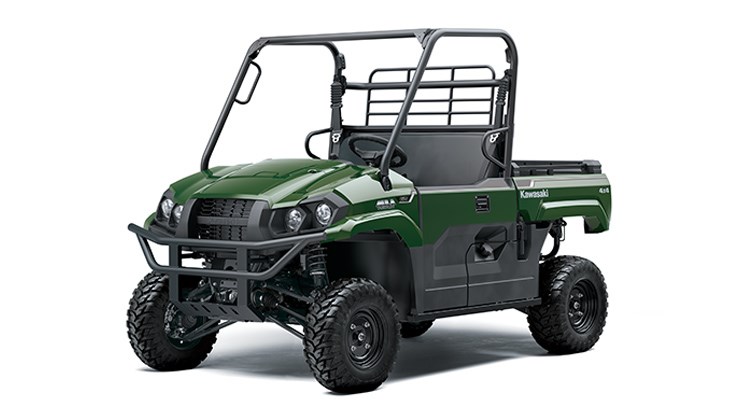 |
| + Electric power steering (EPS) + Folding windshield as option + Generally faster top speed | + Wider range of models + Diesel options + Cheaper |
In 1980, three Kawasaki employees sketched an idea for a vehicle that would revolutionize the way modern farmers, contractors, and outdoorsmen would accomplish tasks. For years, the market was limited by the design of the small, one-passenger ATV.
Forty years later, there are nearly a dozen brands that have joined the UTV manufacturing space. Popular vehicles like the Yamaha Viking were developed for specific drivers in mind and later expanded into special edition or multi-passenger models.
While UTVs sit at the intersection of utility and recreation, brands have since expanded from that “napkin sketch.” Each brand offers its own twist on basic UTV features, which makes research the most important part of your purchase.
The Yamaha Viking and the Kawasaki Mule are two dependable UTVs with excellent track records. Having a hard time choosing a UTV that will fit your needs? Keep reading for our in-depth comparison of the Yamaha Viking vs Kawasaki Mule.
Table of Contents
Yamaha Viking vs Kawasaki Mule Overview
The Utility Terrain Vehicle (also known as a UTV or side-by-side) was designed to carry heavier loads and more passengers than the classic ATV. Because it is engineered to drive like a traditional automobile, it’s an accessible option for those with physical limitations or safety concerns around traditional ATVs.
Kawasaki Mule
The Kawasaki Mule was first introduced in 1988 as the first modern UTV.
Even before they invented the UTV, Kawasaki was known for its innovation in the motorized vehicle world. Since the beginning, Kawasaki has produced airplanes, helicopters, and racing bikes. Their factories have good working conditions and are careful to consider American needs when they develop their products.
This means that Kawasaki makes all vehicles with the weather and terrain in mind.
Both Yamaha and Kawasaki have been developing safe, dependable UTVs for decades. Choosing the right machine will ultimately be decided by the feature options available to you with the current models.
Yamaha Viking
Yamaha presented its own version of the UTV in 2004. The Yamaha Rhino combined style and recreation with dependable utility. It was updated and produced until 2012. A variety of additional Yamaha models are now available.
Yamaha developed its first motorized vehicle in 1955. It is a Japan-based company with factory locations scattered throughout the United States.
Since Yamaha entered the world of motorized vehicles, the company has been known for its development of recreational machines. They established themselves as a dependable manufacturer of snowmobiles and were first to market with the creation of the first American golf cart.
Consumers have generally positive Yamaha Viking reviews.
Feature Comparison
While both companies offer safe, dependable UTV designs, each brand has distinct offerings. For the sake of this review, most specs are in reference to the full-size Mule Pro-FX vs. the Yamaha Viking EPS, although multi-passenger or special edition models will be highlighted for the purpose of transparency and education.
Size
The Kawasaki Mule comes in a wider range of sizes than the Yamaha Viking. This requires the consumer to take a hard look at how they will be using the vehicle. We’ll break down the variance in the size of a few options below:
Kawasaki Mule Two-Passenger Models
- Mule SX Compact
- Mule 4000/4010 Compact
- Mule Pro-MX Compact
Kawasaki Mule Three-Passenger Models
- Mule Pro-FX Full Size
- Mule Pro-DX Diesel Full Size
- Mule Pro-FXR Full Size
Kawasaki Mule Trans- Cab Passenger Models
The Kawasaki Trans-Cab System is a patented technology that allows a driver to transform their two-row passenger cab into a single-row cab. This allows for additional storage and an enhanced hauling function.
Yamaha Viking Three-Passenger Models
- Viking EPS
- Viking EPS Ranch Edition
Yamaha Viking Six-Passenger Models
- Viking VI EPS
Engine
The standard Kawasaki Mule is built with a liquid-cooled, 4-stroke, two-cylinder 695cc engine with fuel injection.
Kawasaki also offers a diesel option (4-stroke, 3-cylinder, OHV, liquid-cooled, diesel/993cc) for the Mule Pro-DXT. This is a great option for farmers and ranchers looking for the extra power to get them through their day.
Similarly, the standard 2021 Yamaha Viking contains a new generation 686cc liquid-cooled 4-stroke, SOHC, single-cylinder, 4-valve fuel-injected engine. The single-cylinder engine results in a dependable work vehicle that excels at lower speeds.
Hauling and Towing Capacity
Due to the hauling and towing capacity variation in each model, we’ll break down the power of a few options below (hauling/towing). California residents will need to be mindful of the laws in their state, and choose their UTV accordingly:
Kawasaki Mule Two-Passenger Models
- Mule SX Compact – 400 lb/1100 lb
- Mule 4000/4010 Compact – 800 lb/1200 lb
- Mule Pro-MX Compact – 700 lb (600 lb California models)/1500 lb
Kawasaki Mule Three-Passenger Models
- Mule Pro-FX Full Size – 1000 lb (600 lb for California models)/2000 lb
- Mule Pro-DX Deisel Full Size – 1000 lb/2000 lb
- Mule Pro-FXR Full Size – 1000 lb (600 lb for California models)/2000 lb
Kawasaki Mule Trans- Cab Passenger Models
The hauling ability of each Trans-Cab model will depend on how many passengers you have riding at the time.
- Mule 4000/4010 Trans 2-Passenger / 4-Passenger models – 800 lb (2-person), 400 lb (4-person)/1200 lb
- Mule Pro-FXT Trans 3-Passenger / 6-Passenger models- 1000 lb (3-person) 350 lb (6-person) (600 lb for California models)/2000 lb
- Mule Pro-DXT 3-Passenger / 6-Passenger models – 1000 lb (3-person) 350 lb (6-person)/2000 lb
Yamaha Viking Three-Passenger Models
- Viking EPS – 600 lb/1500 lb
- Viking EPS Ranch Edition – 600 lb/1500 lb
Yamaha Viking Six-Passenger Models
- Viking VI EPS – 600 lb/1500 lb
Vehicle Suspension
The Kawasaki Mule contains independent suspension and disc brakes in both the front and the rear.
The Yamaha Viking boasts an independent double-wishbone suspension in both the front and rear.
Customizability
Both the Kawasaki Mule and the Yamaha Viking have optional add-ons and accessories to customize the look and function of the vehicle.
Kawasaki Mule
While individual accessories are available for purchase, Kawasaki encourages UTV buyers to consider their side-by-side accessory packages. These packages include:
- Mule SX Utility Package – Plastic Roof, Standard Side Mirror Set, Trailer Hitch, 2″ Chrome Hitch Ball
- Mule SX Adventure Package – Fixed Windshield, Plastic Roof, Brush Guard, Standard Side Mirror Set
- Mule SX Open Range Package – Fixed Windshield, Plastic Roof, LED Light Bar, LED Light Bar Harness Kit, Brush Guard, Cargo Bed Mat, Floor Mat, Cargo Box
Yamaha Viking
Custom à la carte features include:
- A folding windshield
- Heavy-duty front brush guard –
- Highlight brush guard
- A sealed rear window
- Overhead audio system
You’ll want to consider the features that are the most important to you and the vehicle’s intended purpose when comparing the two UTVs.
Affordability and Price
A price breakdown (from lowest to highest) of the most popular Kawasaki Mule utility models include:
- Mule SX – $6,799
- Mule Pro-FX – $12,099
- Mule Pro-DX Diesel – $14,199
- Mule Pro-FXT Trans – $13,099
Check out the official Kawasaki website for additional specs and current prices.
A price breakdown (from lowest to highest) of the most popular Yamaha Viking utility models include:
- Viking – $11,999
- Viking EPS – $13,699
- Viking VI EPS – $14,499
- Viking VI EPS Ranch Edition – $15,799
Check out the official Yamaha website for additional specs and current prices.
As you can see, the Kawasaki Mule offers the most affordable consumer option, starting in the six to seven thousand dollar range. For more than double the price, you could spring for a diesel model.
The Yamaha Viking comes competitively priced, though their most affordable consumer model is significantly higher-priced than the Mule.
Warranty
A UTV warranty guarantees a customer that a manufacturer will replace or repair your investment within a certain time frame.
The industry-leading Kawasaki warranty provides a 3-Year Limited Warranty. This speaks to the confidence Kawasaki has in its products.
A new 2021 Yamaha Viking comes with a 6-Month Limited Factory Warranty and the industry’s first 10-Year Belt Warranty, which means that Yamaha covers all Ultramatic automatic transmission ten years.
Pros vs. Cons
Though each UTV has proven its worth on the market, there are distinct pros and cons of each vehicle that are important to note.
Kawasaki Mule
Consider the pros and cons of the Kawasaki Mule:
Pros
- Price – spend as little as $6,799
- Greatest potential for hauling/towing
- 3-Year Limited Warranty
- Transitional cab options
- Diesel model available
Cons + Kawasaki Mule Problems
- High demand/low availability
- Low top speed
- Reviews complain about noise associated with speed limiter
Yamaha Viking
Consider the pros and cons of the Yamaha Viking:
Pros
- Comfort – staggered seats designed with support in mind
- Electric power steering standard on all EPS models
- Sleek look that can transition to recreational use
Cons + Yamaha Viking Problems
- Single-cylinder
- Thin-plastic exterior
- A common Yamaha Viking review notes intense vibrations in body
Which UTV Is Right for You?
If you are looking for a quiet machine with electric power steering, any model from the Yamaha Viking EPS line would be a worthwhile purchase. Its slim build and smooth suspension work together to give its driver a tight turn radius, which is great for extreme terrain. The Viking EPS Ranch Edition gives drivers more room for additional passengers.
If you want an accessibly-priced UTV that will work hard for you, the Kawasaki Mule has been impressing customers for decades, and are definitely the most popular. The industry-leading 36-month warranty is impossible to beat.
Both vehicles are extremely customizable individual accessories. Make accessorizing easier with the Kawasaki Mule accessory packages, or buy individual add-ons to improve the comfort of the vehicle. With the wide range of models offered by each brand, it is possible to find a specific size that works for your needs and any potential passengers.
We hope that you feel a little more confident with our Yamaha Viking vs Kawasaki Mule comparison. If you’re interested in expanding your options, read more about the Yamaha Viking vs. Honda Pioneer.

